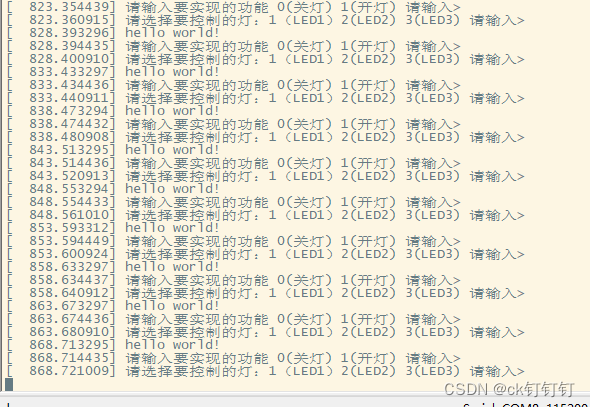基于GPIO子系统编写LED驱动,编写应用程序进行测试设置定时器,5秒钟打印一次hello world
应用程序 test.c
#include <stdlib.h>
#include <stdio.h>
#include <sys/types.h>
#include <sys/stat.h>
#include <sys/ioctl.h>
#include <fcntl.h>
#include <unistd.h>
#include <string.h>
int main(int argc, char const *argv[])
{
char buf[128] = {0};
int a, b;
int fd = open("/dev/myled0", O_RDWR);
if (fd < 0)
{
printf("打开设备文件失败\n");
exit(-1);
}
while (1)
{
// 从终端读取
scanf("%d", &a);
scanf("%d", &b);
switch (a)
{
case 1:
ioctl(fd, 1, b);
break;
case 0:
ioctl(fd, 0, b);
break;
}
}
close(fd);
return 0;
}
驱动文件demo.c
#include <linux/init.h>
#include <linux/module.h>
#include <linux/of.h>
#include <linux/of_gpio.h>
#include <linux/gpio.h>
#include <linux/timer.h>
#include <linux/fs.h>
#include <linux/uaccess.h>
#include <linux/io.h>
#include <linux/device.h>
/* myled
{
led1-gpio=<&gpioe 10 0>;
led2-gpio=<&gpiof 10 0>;
led3-gpio=<&gpioe 8 0>;
};
*/
struct device_node *dnode;
// unsigned int gpiono;
struct gpio_desc *gpiono[3];
char *str[3] = {"led1-gpio", "led2-gpio", "led3-gpio"};
struct timer_list mytimer;
// 封装操作方法
int major;
char kbuf[128] = {0};
struct class *cls;
struct device *dev;
int mycdev_open(struct inode *inode, struct file *file)
{
printk("%s:%s:%d\n", __FILE__, __func__, __LINE__);
return 0;
}
long mycdev_ioctl(struct file *file, unsigned int cmd, unsigned long arg)
{
printk("%s:%s:%d\n", __FILE__, __func__, __LINE__);
// arg-1 : 0=led1 1=led2 2=led3
// cmd = 0 关灯,cmd = 1 开灯
gpiod_set_value(gpiono[arg - 1], cmd);
return 0;
}
int mycdev_close(struct inode *inode, struct file *file)
{
printk("%s:%s:%d\n", __FILE__, __func__, __LINE__);
return 0;
}
// 定义操作方法结构体变量并赋值
struct file_operations fops = {
.open = mycdev_open,
.unlocked_ioctl = mycdev_ioctl,
.release = mycdev_close,
};
void mytimer_function(struct timer_list *timer)
{
// 每5s打印一次hello world!
printk("hello world!\n");
printk("请输入要实现的功能 0(关灯) 1(开灯) 请输入>\n");
printk("请选择要控制的灯:1(LED1)2(LED2) 3(LED3) 请输入>\n");
mod_timer(timer, jiffies + 5 * HZ);
}
static int __init mycdev_init(void)
{
// 字符设备驱动注册
major = register_chrdev(0, "mychrdev", &fops);
if (major < 0)
{
printk("字符设备驱动注册失败\n");
return major;
}
printk("字符设备驱动注册成功:major=%d\n", major);
// 向上提交目录
cls = class_create(THIS_MODULE, "mychrdev");
if (IS_ERR(cls))
{
printk("向上提交目录失败\n");
return -PTR_ERR(cls);
}
printk("向上提交目录成功\n");
// 向上提交设备节点信息
// 向上提交三次设备节点信息
dev = device_create(cls, NULL, MKDEV(major, 0), NULL, "myled%d", 0);
if (IS_ERR(dev))
{
printk("向上提交设备节点失败\n");
return -PTR_ERR(dev);
}
printk("向上提交设备节点成功\n");
// 解析设备树节点信息
dnode = of_find_node_by_path("/myled");
if (dnode == NULL)
{
printk("解析设备树节点失败\n");
return -ENXIO;
}
// 获取LED GPIO编号
int i = 0;
for (i = 0; i < 3; i++)
{
gpiono[i] = gpiod_get_from_of_node(dnode, str[i], 0, GPIOD_OUT_LOW, NULL);
if (IS_ERR(gpiono[i]))
{
printk("申请gpio信息失败\n");
return -PTR_ERR(gpiono[i]);
}
}
// 初始化定时器对象
timer_setup(&mytimer, mytimer_function, 0);
mytimer.expires = jiffies + 5 * HZ; // 定时5s
// 注册定时器
add_timer(&mytimer);
return 0;
}
static void __exit mycdev_exit(void)
{
// 注销定时器
del_timer(&mytimer);
int i = 0;
for (i = 0; i < 3; i++)
{
// gpio_set_value(gpiono,0);
gpiod_set_value(gpiono[i], 0);
// 释放GPIO编号
// gpio_free(gpiono);
gpiod_put(gpiono[i]);
}
// 销毁设备节点信息
device_destroy(cls, MKDEV(major, 0));
// 销毁目录
class_destroy(cls);
// 注销字符设备驱动
unregister_chrdev(major, "mychrdev");
}
module_init(mycdev_init);
module_exit(mycdev_exit);
MODULE_LICENSE("GPL");
效果:

在终端输入对应1 0 / 123 就可以控制开发板上led1,led2,led3的亮灭
